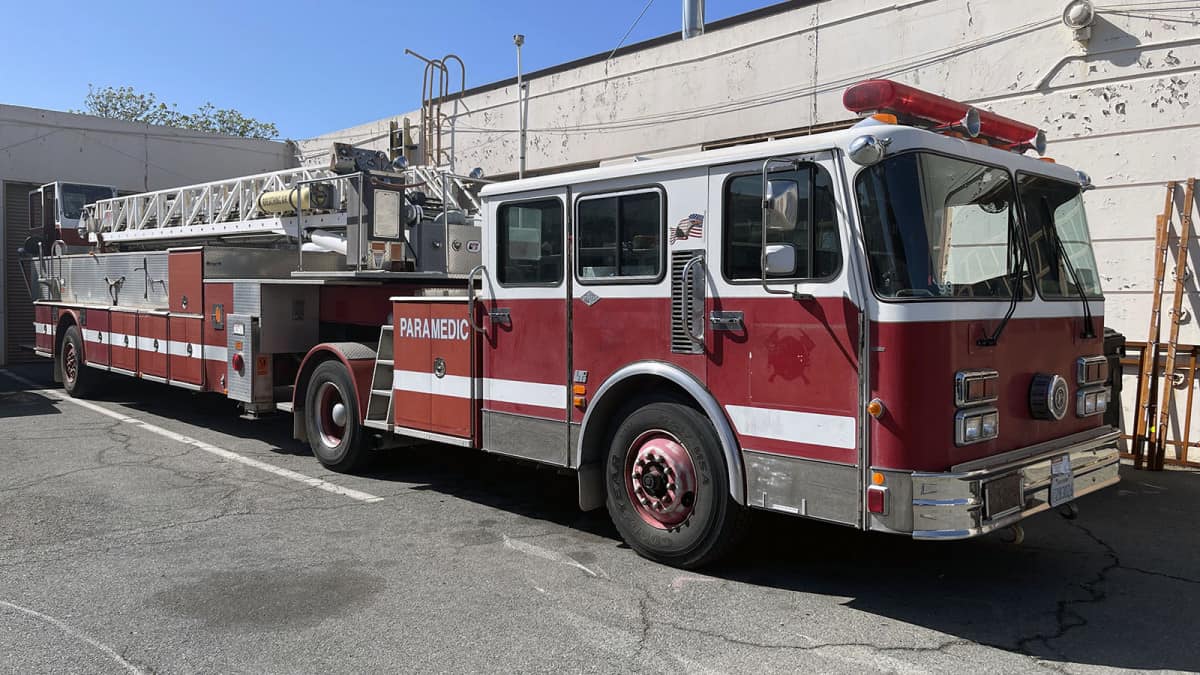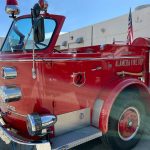Station One, January 1973, 10:00 p.m. — There’s That Horse Manure Again
Four years had passed and I’m on duty at our “new” Station One at the corner of Encinal and Park Streets. Probation was completed. I had quite a few fires under my belt; I was beginning to feel that I was truly accepted and pretty comfortable in the fire department. The time was 2200 hours. I had just left Harry, Moe, Ed, and Otis in the dayroom to check out the rigs before bed.

I was driving Truck One that night, a 1972 Seagrave 100-foot aerial, powered by an 8V71 Detroit Diesel, with a six-speed automatic Allison transmission. Since the day I first saw and heard it, I knew it was mine to tame. Coming from the lights of the dayroom into the dimness of the apparatus room, there was that smell I loved so much: diesel from the rigs and smoke emanating from a row of turnout coats and helmets.
I surveyed the equipment and was struck by the stillness in this barn full of great steeds calmly in their stalls, fully equipped and quiet.
Again, my mind is in the 1890’s. I could feel a tension, I could hear the shake of a head and swish of the mane, I could see flesh on the horse’s back ripple and hooves clicking on the pavement. There was a munching of hay, and a slight whinny of greeting as I drew near. Their muscles were flexed yet tethered, waiting to be spurred into life. The satisfaction of knowing that I could control this power was thrilling.
Now I think of the fragment of leather bridle I still have from the horse my great-grandfather rode to many fires in his 30 years as chief in Grand Rapids, Michigan. His brother was a captain, his son, my grandfather. Dad had told me their stories and of my grandfather who was also a chief in Richmond, California. Granddad’s brother-in-law was a mechanic for Richmond and assembled their first aerial ladder truck.
Uncle Pat tells of his early years tending the fire horses, Jennie and Bessie. As I mentioned before, these horses would stand quietly in their open stalls until the alarm bells struck. With the first strike, the fillies would start to snort and prance; if the sequence of bells was right, they knew by the count, and would move out under the harnesses that hung from the apparatus room ceiling. The harnesses were pre-attached to the steamer.
The teamster would lower the harnesses, cinch the buckles, and take his position at their reigns, with a look over his shoulder to see if the men were through stoking the burners and onboard. A quick nod from the captain and they were off. I wish I could have experienced that. The closest I’ll ever be to them is in the dim light of this garage, standing in their footsteps, feeling their spirits.
The glow from the dispatch room and one 60-watt bulb on the opposite wall were the only source of illumination. Truck One (5-1) was to the far left at the front, Engine One (6-1) to its right, then came a 1960’s vintage Ford station wagon (resuscitator car) and the chief’s car. I walked to Truck One and mentally went through every cabinet to remind myself of the equipment stored within; then to Engine One, a 1968 Mack, 864 cubic inch twin turbo V8. From the driver’s seat, I started my simulated check. Lights, pump, engagement lever, rev engine to see tachometer and speedometer move to be sure that the pump is engaged and set the air brakes.
As I moved from the cab to the pump panel, I always walked out away from the rig to look at the panel from a distance (perspective) to see and count every gate (valve), tank dump, live line gate, pressure relief, and gauges. Then, closing my eyes, I would touch every gate handle. Better to do this at 10:00 p.m. than to be fumbling for gate 3 or 5, and the live line at 3:00 in the morning, blurry eyed with people screaming, “Give me water!” I must confess at this point that I am truly in love with these mechanical marvels.

2:00 a.m.: I awoke to the Buck Horn and Driftwood bars across the street unloading their drunks. The gas station had cars coming and going, and every kid in Alameda was hanging out at Jack in the Box. Don’t they know we need our sleep? Summertime is the worst; Station One is cinder block construction without air conditioning. We needed the windows open, but the noise was terrible.
As I rested there trying to get back to sleep, my eyes surveyed the dark quiet of the dorm. Across the room I could see the glow of a cigarette as Ed took a few drags and returned to sleep. In another location I could see the glow of a cigarette sitting on its filter on the seat of a wooden chair burning itself out… could be Jack. Only in a fire station, I mused. Quite a few of the old timers did this. Often, when cleaning the dorm, we would find burned out cigarettes sitting upright on their filters or a scorch spot on the chair. Times truly have changed, but I will always desire the ancient paths.
Station One, Mid 1970’s, 1:00 a.m.

The crew was catching Z’s. At this time, we were dispatched from the main station. When a call came in, all stations heard the initial conversation. I awakened to the voice of Archie and the often-heard phrase, “Alameda Fire Department.” The plea of a female voice on the other end was so alarming, “There’s fire coming out the windows of a house across the street and people are trapped!”
Before the lights dropped (turned on) or we were dispatched, the beds were emptied, and everyone was moving down the stairs and across the apparatus room to the rigs. I was driving Truck One. Otis was driving Engine One, “What’s the address?”
“Otis Drive at Park Avenue.”
With adrenalin pumping, I stepped up and slipped behind the wheel of the truck. “Hey, Otis, it’s on Otis Drive!”
With my left hand, I hit the two starter buttons and the Detroit diesel came to life. What a sweet sound. A sweep of my right fingers across the dash and all the lights were on.
Otis already had the Mack started. With my right hand I turned the batteries, disconnected two clicks. With my left hand, I hit the two starter buttons and the Detroit diesel came to life. What a sweet sound. A sweep of my right fingers across the dash and all the lights were on. The dash panel has always looked great lit up, and the rotating beacons reflecting off the walls and other apparatus added more adrenalin to the mix. “Come on, lieutenant. Let’s go!” Engine One is out the door and a half block away as we pull onto Encinal and left onto Park Street. I’ll catch them, no sweat.
Dispatch is on the radio to Engine One: “We’ve received numerous calls. There seems to have been an explosion. People are trapped.”
Engine One was accelerating through San Jose Avenue. The Mac-O-Dine diesel has always been set too fuel-rich; we could tell when the engineer has his foot in it or was changing gears from the black smoke of the exhaust. Still, Truck One had pulled within 300 feet. As we neared the intersection of Park Street and Otis Drive, the engine was in the turn, and we could see the reflection of fire and light on its side. I looked as we came around the corner and saw people running frantically, silhouetted in the flames.
The call from the captain on Engine One: “A fully involved duplex. Engine One to Central, we’ll be pulling the live line and going in the front door. Central to Engine Three, pull Engine One a supply line.”
“Engine Three, Roger, will do.”
Engine One was directly in front of the house. We staged across the street and a little forward as we didn’t need the aerial. My crew has gone to rescue. Being a dry foot (driver), I stayed with the truck. No ladders were needed so I pulled a supply line from Engine One to the hydrant and turned on the water.
It’s always a great feeling when the water fills the hose and the Engineer, Otis, acknowledges with relief, “We have water!”
Engine Three had arrived; they were pulling more lines around the back. People on the sidewalk were screaming, “People are inside!”
All immediate tasks were covered. What could I do? I pulled another pre-connected line and shoved it in the front window as the fire was still resisting entry through the front of the building. The captain and Bob were finally making headway through the door, but it was tough going. The fire was so hot and was beating them back. I thought to myself, people are in there, as I charged my line and hit the fire, it blew back in my face, hot and wet. I ducked a little and kept my line in until Steck and Bob were inside.
Back to the truck for the generator because they needed lights. As I pulled the extension cord and flood lights through the door and illuminated the now darkened structure, the scene in the front room took me aback, soot-covered walls radiating heat, the odor of wet, charred wood, two over-stuffed chairs, a coffee table, a queen-sized hide-a-bed opened out, and two motorcycles. Wait! Motorcycles? What the hell are two motorcycles doing in the living room?
The guys found Peggy behind a partially burned sliding door, right where my line had been trained. I didn’t realize, when I stuffed the hose in the window, that I was protecting and cooling her with the water curtain. In the back bedroom, George found a naked teenage boy and was trying to carry him through the living room and out, but he needed more help as the boy’s skin was slippery and hard to hold onto; we were calf deep in water.
As I set the floodlights down, I received a severe shock. The extension cord had a short. They needed light and muscle. It was my choice to hold the lights out of the water as other guys assisted in the rescue. It was too late; the boy was dead. Not a burn mark visible; smoke and heat got him, with a window just a couple of feet away. Peggy was still alive as they carried her by me. The scene was utter pandemonium; men silhouetted in my light were yelling and tripping as we tried to intervene on the inevitable. She was outside and being transported.
The fire was extinguished and cleanup underway. Probably within a half hour, life had changed to death. For what? A floor heater and a motorcycle gas tank… Crazy kids, you should have known better. No smoke detector. As I look at where Peggy was laying, it seems clear that she got up hearing the boys running to the back side of the house. She must have opened the sliders not knowing that the main fire was on the other side. That’s where she dropped, just two feet from a window opening and safety. The next day we heard that Peggy needed blood; we more than filled the request. That’s also what firefighters do. She only lived a couple of weeks. So close, yet another tragedy.
David LeMoine is retired from the Alameda Fire Department and now lives in Eagle, ID. These stories are excerpted from his book, I Could Have Died a Thousand Deaths, published by Big Boots Publishing of Redding, CA.





